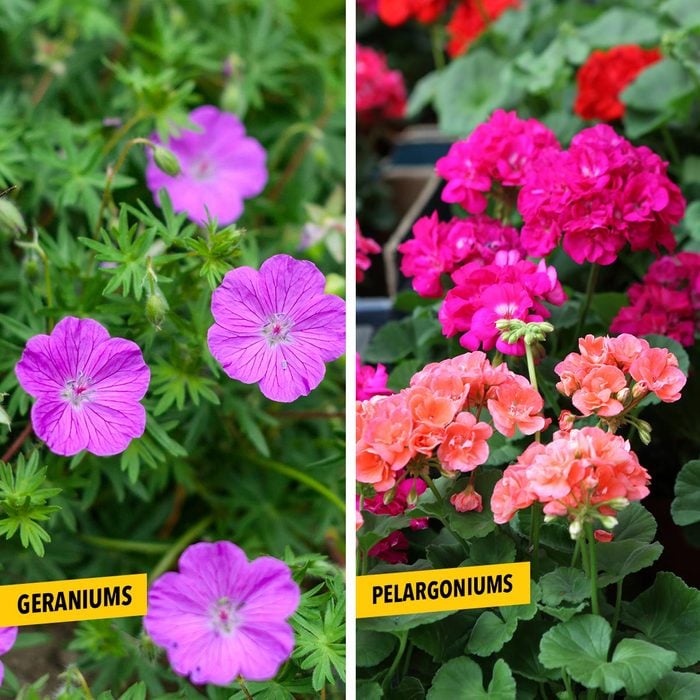What’s the Difference Between Geraniums and Pelargoniums?
Updated: Apr. 09, 2024

You think you know geraniums but haven't heard of pelargoniums? One is a perennial and the other is grown as an annual. Find out which is which!
Our editors and experts handpick every product we feature. We may earn a commission from your purchases.
In my front garden (in U.S. Department of Agriculture hardiness zone 6b) I grow Geranium ‘Rozanne, a perennial geranium with light purplish-blue flowers that blooms almost all summer. It weaves its blooms in and around other plants, giving my garden a loose cottage garden feel. On my back patio, I have pots of several different types of geraniums with colorful foliage and red and pink flowers.
But even though I call my potted flowers “geraniums”, they are actually “pelargoniums”.
Here’s the difference.
On This Page
Are Pelargoniums and Geraniums the Same Plant?
Pelargoniums and geraniums are related, but not quite the same. Both plants are part of the same species, Geraniaceae. There is one main difference that separates them. Geraniums are perennial plants that come back every year. Pelargoniums, on the other hand, are annuals and generally only last for one growing season.
What Are Pelargoniums?
Pelargoniums are popular annuals (or half-hardy annuals that tolerate cool temps but not frost) and are often grown in containers. Flower colors range from white to all shades of pink and red. They are originally from warm climates like South Africa and Australia.
Types of Pelargoniums
There are several types of pelargoniums. Somewhat confusingly, they are all usually labeled with the common name geranium.
- Zonal geraniums are the most common type, named for the pattern on the leaves. The most popular flower color is red, but they also come in pinks, corals and white. One of my favorite varieties is Calliope Dark Red.
- Scented geraniums are grown for their leaves which when crushed have various scents, such as citrus, clove, chocolate or cinnamon. Those with citrus-scented leaves are often sold as Citronella. Dried leaves of scented geraniums can be used in potpourri mixes.
- Ivy geraniums have trailing stems, making them ideal for hanging baskets.
- Seed geraniums are smaller plants and are usually less expensive than zonal geraniums, making them a good choice if you want to plant many in the ground. Seed geraniums generally don’t have markings on their leaves.
- Martha Washington geraniums are a special type of geranium that prefers cooler temps to bloom and is often sold as a potted flowering gift plant.
What Are True Geraniums?
True Geraniums are perennial flowers with the genus name Geranium. They are usually hardy in U.S. Department of Agriculture hardiness zones 4 through 8.
Types of True Geraniums
There are several popular varieties of true (sometimes called hardy) geraniums:
- Geranium ‘Rozanne’ grows up to 18 inches tall and blooms continually from June through September with light bluish-purple flowers.
- Geranium ‘Biokovo’ is more of a ground cover-type plant, topping out at around 10 inches. It has light pink flowers in the spring. Its foliage turns red in the fall.
- Geranium ‘Johnson’s Blue’ has flowers that are more blue, flowering mid-spring to early summer.
How To Grow True Geraniums
Once established, true geraniums are reliable perennial flowers.
- Choose a location with full sun and well-drained soil. The front of a flower border is a good location for geraniums, especially those that are shorter.
- Clear the area of weeds and break up the soil if needed.
- Plant true geraniums any time from spring through early fall.
- Provide extra water the first year to give the newly planted geraniums the equivalent of one inch of rain per week until established.
- Prune back old foliage in late winter before new foliage emerges in spring.
- Once established, true geraniums will tolerate dry periods and are usually deer-resistant. They are rarely bothered by insects or plant diseases
How To Grow Pelargoniums
Pelargoniums are easy to grow, especially as potted plants.
- Choose larger containers if growing several pelargoniums together or smaller pots if planting one plant per pot.
- Fill the container with a general-purpose potting mix and plant the pelargonium in the mix.
- Water well and keep watered through the growing season. Smaller pots may need to be watered twice a day during really hot spells.
- Fertilize occasionally with a general-purpose fertilizer.
- Remove spent blooms to encourage more blooms throughout the summer.
- Pelargoniums can be overwintered as houseplants or by saving bare-root plants or cuttings.
- Pelargoniums are not usually bothered by diseases or pests but watch for mealybugs on indoor-grown plants. Even Japanese beetles avoid them!
